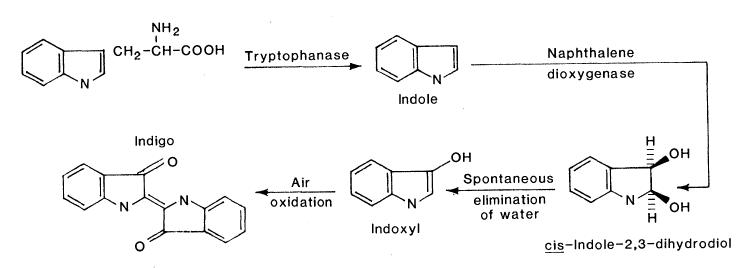Team:Cornell/testing/project/wetlab/4/6
From 2012.igem.org
(Difference between revisions)
| Line 82: | Line 82: | ||
<div class="nine columns"> | <div class="nine columns"> | ||
<h3>Biosynthesis of Indigo</h3> | <h3>Biosynthesis of Indigo</h3> | ||
| - | + | It was discovered that when the NAH7 operon is transformed into <i>E. coli</i> and expressed, the cells have the ability to produce indigo from tryptophan. Therefore, as an indirect proof of the NAH operon's function, several cultures were set up to determine if indigo was present when supplemented with 200 μM tryptophan. | |
| + | <br><br> | ||
| + | Ensley, B., Ratzkin, B., Osslund, T., Simon, M., Wackett, L., & Gibson, D. (1983). Expression of naphthalene oxidation genes in <i>Escherichia coli</i> results in the biosynthesis of indigo. <i>Science</i>, 222(4620), 167-9. | ||
| + | <br><br> | ||
</div> | </div> | ||
</div> | </div> | ||
| + | <div class="twelve columns"> | ||
| + | <img class="inline" src="https://static.igem.org/mediawiki/2012/a/a1/IndigoReaction.jpg"> | ||
| + | <b> Fig. 1. Pathway by which <i>E. coli</i> can produce indigo from tryptophan when expressing genes of the NAH7 operon. (Ensley et al., 1983) | ||
| + | </b><br><br> | ||
| + | |||
| + | </div> | ||
</div> | </div> | ||
</div> | </div> | ||
Revision as of 22:05, 3 October 2012
-
Wet Lab
- Overview
- Chassis
- DNA Assembly
- Testing & Results
- Future Work
- Animation
Naphthalene Growth Assays
Naphthalene as a Sole Carbon Source
Lorem ipsum dolor sit amet, consectetur adipisicing elit, sed do eiusmod tempor incididunt ut labore et dolore magna aliqua. Ut enim ad minim veniam, quis nostrud exercitation ullamco laboris nisi ut aliquip ex ea commodo consequat. Duis aute irure dolor in reprehenderit in voluptate velit esse cillum dolore eu fugiat nulla pariatur. Excepteur sint occaecat cupidatat non proident, sunt in culpa qui officia deserunt mollit anim id est laborum.

Biosynthesis of Indigo
It was discovered that when the NAH7 operon is transformed into E. coli and expressed, the cells have the ability to produce indigo from tryptophan. Therefore, as an indirect proof of the NAH operon's function, several cultures were set up to determine if indigo was present when supplemented with 200 μM tryptophan.Ensley, B., Ratzkin, B., Osslund, T., Simon, M., Wackett, L., & Gibson, D. (1983). Expression of naphthalene oxidation genes in Escherichia coli results in the biosynthesis of indigo. Science, 222(4620), 167-9.
 Fig. 1. Pathway by which E. coli can produce indigo from tryptophan when expressing genes of the NAH7 operon. (Ensley et al., 1983)
Fig. 1. Pathway by which E. coli can produce indigo from tryptophan when expressing genes of the NAH7 operon. (Ensley et al., 1983)
 "
"







